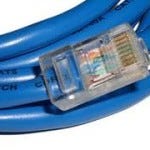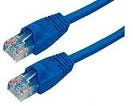Network cable is a “twisted-pair copper” data cable (sometimes known as a patch cable) that is used to hook network devices up together. Network devices are things like computers, printers, servers, gaming consoles and multi-media players. The great thing about network cables is that data can be transferred quickly, cheaply and reliably without the need to be spending a fortune. As more and more devices have network cable ports, it’s a very easy and cost effective way of sorting out your system. Network cable comes in various colours which really helps if you want to be able to easily identify which cable is connected to which device. Network cable is also referred to by its’ category number. You may have heard these called Cat5, Cat5e or Cat6.
Cat 5 cables are the most basic, and are either solid or stranded: Solid Cat 5 is more rigid, and a good choice if data needs to be transmitted over a long distance, while Stranded Cat 5 is very flexible and most likely to be used as patch cable.
Cat 5e (which stands for Cat 5 enhanced) is obviously similar to Cat 5, except it is able to send higher levels of data transmission.
Cat 6 is currently the highest standard of network cable, typically with four twisted pairs of copper wire. What sets it apart from Cat 5 cables is the isolating separator which keeps the four pairs from touching, reducing crosstalk and allowing faster data transmission. Cat 6 also has twice the bandwith of Cat 5 which makes it the best choice when taking into consideration future requirements you may have. Planning for future needs cannot be overstated, as you simply don’t know what you may need down the track.
Using network cable is a great way for homes to set up a central hub with a server to run the entire house. You can store all the household information like music, movies and photos in one place so any room can access the information. This allows for a huge amount of flexibility in your home.
Obviously it is ideal to run the cabling prior to installing your plasterboard, however it’s not always possible. If you’re not sure about how or where you should run your cable, it is recommended having a network system designed for you by an installer. If possible, it is always better to be on the safe side and run more than you think you will need. It is a comfort knowing there is cable hiding behind the wall ready for use, rather than thinking about how to get it in there later.
If you need advice or suggestions for your own situation, please call the Selby Techs on 1800 69 2225








